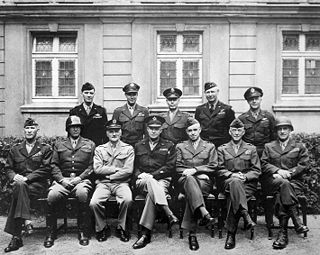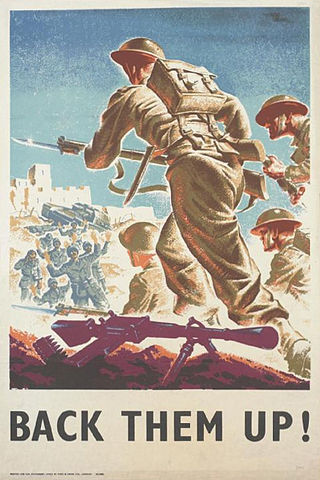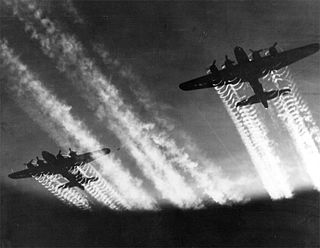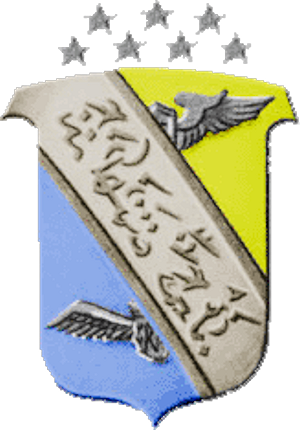The List of major U.S. Commands of World War II includes major military commands of the United States. These are units above corps level.

The European Theater of Operations, United States Army (ETOUSA) was a theater of Operations responsible for directing United States Army operations throughout the European theatre of World War II, from 1942 to 1945. It commanded Army Ground Forces (AGF), United States Army Air Forces (USAAF), and Army Service Forces (ASF) operations north of Italy and the Mediterranean coast. It was bordered to the south by the North African Theater of Operations, United States Army (NATOUSA), which later became the Mediterranean Theater of Operations, United States Army (MTOUSA).

The military history of the United Kingdom in World War II covers the Second World War against the Axis powers, starting on 3 September, 1939 with the declaration of war by the United Kingdom and France, followed by the UK's Dominions, Crown colonies and protectorates on Nazi Germany in response to the invasion of Poland by Germany. There was little, however, the Anglo-French alliance could do or did do to help Poland. The Phoney War culminated in April 1940 with the German invasion of Denmark and Norway. Winston Churchill became prime minister and head of a coalition government in May 1940. The defeat of other European countries followed – Belgium, the Netherlands, Luxembourg and France – alongside the British Expeditionary Force which led to the Dunkirk evacuation in June 1940.

The Seventh Air Force (Air Forces Korea) (7 AF) is a Numbered Air Force of the United States Pacific Air Forces (PACAF). It is headquartered at Osan Air Base, South Korea.

The Thirteenth Expeditionary Air Force is a provisional numbered air force of the United States Air Force Pacific Air Forces (PACAF). It is headquartered at Hickam Air Force Base, Joint Base Pearl Harbor–Hickam on the island of Oahu, Hawaii. It has never been stationed in the continental United States.

The Asiatic–Pacific Campaign Medal is a United States military award of the Second World War, which was awarded to any member of the United States Armed Forces who served in the Asiatic-Pacific Theater from 1941 to 1945. The medal was created on November 6, 1942, by Executive Order 9265 issued by President Franklin D. Roosevelt. The medal was designed by Thomas Hudson Jones; the reverse side was designed by Adolph Alexander Weinman which is the same design as used on the reverse of the American Campaign Medal and European-African-Middle Eastern Campaign Medal.

The South-East Asian Theatre of World War II consisted of the campaigns of the Pacific War in the Philippines, Thailand, Indonesia, Indochina, Burma, India, Malaya and Singapore between 1941 and 1945.
The Mediterranean Theater of Operations, United States Army (MTOUSA), originally called the North African Theater of Operations, United States Army (NATOUSA), was a military formation of the United States Army that supervised all U.S. Army forces which fought in North Africa and Italy during World War II.

South West Pacific Area (SWPA) was the name given to the Allied supreme military command in the South West Pacific Theatre of World War II. It was one of four major Allied commands in the Pacific War. SWPA included the Philippines, Borneo, the Dutch East Indies, East Timor, Australia, the Territories of Papua and New Guinea, and the western part of the Solomon Islands. It primarily consisted of United States and Australian forces, although Dutch, Filipino, British, and other Allied forces also served in the SWPA.

Thomas Cassin Kinkaid was an admiral in the United States Navy, known for his service during World War II. He built a reputation as a "fighting admiral" in the aircraft carrier battles of 1942 and commanded the Allied forces in the Aleutian Islands Campaign. He was Commander Allied Naval Forces and the Seventh Fleet under General of the Army Douglas MacArthur in the Southwest Pacific Area, where he conducted numerous amphibious operations, and commanded an Allied fleet during the Battle of Leyte Gulf, the largest naval battle of World War II and the last naval battle between battleships in history.

Pacific Ocean Areas was a major Allied military command in the Pacific Ocean theater of World War II. It was one of four major Allied commands during the Pacific War and one of three United States commands in the Asiatic-Pacific Theater. Admiral Chester W. Nimitz of the U.S. Navy, Commander in Chief, U.S. Pacific Fleet, headed the command throughout its existence.

The South Pacific Area (SOPAC) was a multinational U.S.-led military command active during World War II. It was a part of the U.S. Pacific Ocean Areas under Admiral Chester Nimitz.

Vice Admiral Daniel Edward Barbey was an officer in the United States Navy who served in World War I and World War II. A graduate of the Naval Academy, he participated in the 1912 United States occupation of Nicaragua and the 1915 United States occupation of Veracruz. While serving with the War Plans Section of the Bureau of Navigation in Washington, D.C. between the World Wars, developed an interest in amphibious warfare. In 1940 he produced Fleet Training Publication 167 – Landing Operations Doctrine, United States Navy, which would become the Navy's "bible" of amphibious operations, and would remain in use throughout World War II.

The Eleventh Air Force (11 AF) is a Numbered Air Force of the United States Air Force Pacific Air Forces (PACAF). It is headquartered at Joint Base Elmendorf–Richardson, Alaska.

The military history of the United States during World War II covers the nation's role as one of the major Allies in their victory over the Axis Powers. The United States is generally considered to have entered the conflict with the 7 December 1941 surprise attack on Pearl Harbor by the Empire of Japan and exited it with the 2 September 1945 surrender of Japan. During the first two years of World War II, the US maintained formal neutrality, which was officially announced in the Quarantine Speech delivered by US President Franklin D. Roosevelt in 1937. While officially neutral, the US supplied Britain, the Soviet Union, and China with war materiel through the Lend-Lease Act signed into law on 11 March 1941, and deployed the US military to replace the British forces stationed in Iceland. Following the 4 September 1941 Greer incident involving a German submarine, Roosevelt publicly confirmed a "shoot on sight" order on 11 September, effectively declaring naval war on Germany and Italy in the Battle of the Atlantic. In the Pacific Theater, there was unofficial early US combat activity such as the Flying Tigers.

The United States Fleet Marine Forces (FMF) are combined general- and special-purpose forces within the United States Department of the Navy that perform offensive amphibious or expeditionary warfare and defensive maritime employment. The Fleet Marine Forces provide the National Command Authority (NCA) with a responsive force that can conduct operations in any spectrum of conflict around the globe.
Sea Frontiers were several, now disestablished, commands of the United States Navy as areas of defense against enemy vessels, especially submarines, along the U.S. coasts. They existed from 1 July 1941 until in some cases the 1970s. Sea Frontiers generally started at the shore of the United States and extended outwards into the sea for a nominal distance of two hundred miles.

The 350th Fighter Group was an air combat unit of the United States Army Air Force formed in 1942 and inactivated in 1945. The fighter group consisted of 345th, 346th and 347th Fighter Squadron. The group was formed in England in 1942 flying Bell P-39 Airacobras and participated in the Mediterranean and North African Campaigns of World War II. 350th Fighter Group was based in North Africa, in Algeria and Morocco from January to July 1943. They then moved on to the Mediterranean islands of Sardinia and Corsica in November 1943 and February 1944 and were based in Italy from September 1944 to July 1945. After the group was inactivated on 7 November 1945 at Seymour Johnson Air Force Base following the end of the war. It was redesignated the 112th Fighter Group and placed under the control of the Pennsylvania Air National Guard in 1946.

This is a list of United States Army Air Forces Consolidated B-24 Liberator units and formations during World War II including variants and other historical information. Heavy bomber training organizations primarily under II Bomber Command in the United States and non-combat units are not included.

The Army Air Forces Antisubmarine Command was formed in the fall of 1942 to establish a single command to control antisubmarine warfare (ASW) activities of the Army Air Forces (AAF). It was formed from the resources of I Bomber Command, which had been carrying out the antisubmarine mission in the Atlantic and Caribbean since the Attack on Pearl Harbor due to the lack of long range Naval aviation in that area.

The 361st Tactical Missile Squadron is an inactive United States Air Force unit. It was formed in 1985 by the consolidation of the 1st Antisubmarine Squadron and the 661st Bombardment Squadron. However, the squadron was ever active under its new title.